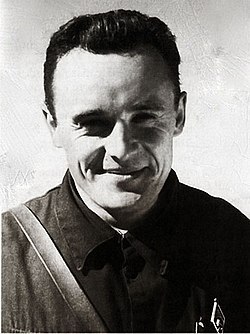
Back Serguei Koroliov AN سيرجي كوروليوف Arabic سيرجى كوروليوف ARZ Serguéi Koroliov AST Sergey Korolyov AZ Королёв Сергей Павлович BA Сяргей Паўлавіч Каралёў BE Сергей Корольов Bulgarian Sergei Korolyov BR Sergej Koroljov BS
Sergei Korolev | |
|---|---|
| Сергей Королёв Сергій Корольов | |
 Korolev in 1934 | |
| Born | 12 January 1907 [O.S. 30 December 1906] |
| Died | 14 January 1966 (aged 59) Moscow, Russian SFSR, Soviet Union |
| Resting place | Kremlin Wall Necropolis, Moscow |
| Education | Kiev Polytechnic Institute Bauman Moscow State Technical University |
| Occupation(s) | Rocket engineer, lead designer of the Soviet space program |
| Spouse(s) | Ksenia Vincentini Nina Ivanovna Kotenkova[1] |
| Children | 1 |
| Military career | |
| Allegiance | Soviet Union |
| Service | Soviet Army |
| Years of service | 1945–1952 |
| Rank | Colonel |
| Signature | |
| Part of a series of articles on the |
| Soviet space program |
|---|
Sergei Pavlovich Korolev[a][b][c] (12 January 1907 [O.S. 30 December 1906] – 14 January 1966) was the lead Soviet rocket engineer and spacecraft designer during the Space Race between the United States and the Soviet Union in the 1950s and 1960s. He invented the R-7 Rocket, Sputnik 1, and was involved in the launching of Laika, Sputnik 3, the first human-made object to make contact with another celestial body, Belka and Strelka, the first human being, Yuri Gagarin, into space, Voskhod 1, and the first person, Alexei Leonov, to conduct a spacewalk.[3]
Although Korolev trained as an aircraft designer, his greatest strengths proved to be in design integration, organization and strategic planning. Arrested on a false official charge as a "member of an anti-Soviet counter-revolutionary organization" (which would later be reduced to "saboteur of military technology"), he was imprisoned in 1938 for almost six years, including a few months in a Kolyma labour camp. Following his release he became a recognized rocket designer and the key figure in the development of the Soviet Intercontinental ballistic missile program. He later directed the Soviet space program and was made a Member of Soviet Academy of Sciences, overseeing the early successes of the Sputnik and Vostok projects including the first human Earth orbit mission by Yuri Gagarin on 12 April 1961. Korolev's unexpected death in 1966 interrupted implementation of his plans for a Soviet crewed Moon landing before the United States 1969 mission.
Before his death he was officially identified only as Glavny Konstruktor (Главный Конструктор), or the Chief Designer, to protect him from possible Cold War assassination attempts by the United States.[4] Even some of the cosmonauts who worked with him were unaware of his last name; he only went by Chief Designer.[3] Only following his death in 1966 was his identity revealed, and he received the appropriate public recognition as the driving force behind Soviet accomplishments in space exploration during and following the International Geophysical Year.[5]
- ^ Harford 1997, pp. 25, 94.
- ^ Harford 1997, p. xvi.
- ^ a b West, John B. (1 October 2001). "Historical aspects of the early Soviet/ Russian crewed space program". Journal of Applied Physiology. 91 (4): 1501–1511. doi:10.1152/jappl.2001.91.4.1501. PMID 11568130. S2CID 24284107. Archived from the original on 16 November 2017. Retrieved 5 June 2017.
- ^ Scott and Leonov, p. 53. Harford, p. 135.
- ^ "Late great engineers: Sergei Korolev – designated designer". 6 January 2021. Retrieved 1 October 2021.
Cite error: There are <ref group=lower-alpha> tags or {{efn}} templates on this page, but the references will not show without a {{reflist|group=lower-alpha}} template or {{notelist}} template (see the help page).